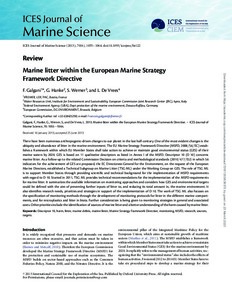| dc.contributor.author | Galgani, F. | |
| dc.contributor.author | Hanke, G. | |
| dc.contributor.author | Werner, S. | |
| dc.contributor.author | De Vrees, L. | |
| dc.coverage.spatial | European | en_US |
| dc.date.accessioned | 2020-04-02T18:23:24Z | |
| dc.date.available | 2020-04-02T18:23:24Z | |
| dc.date.issued | 2013 | |
| dc.identifier.citation | Galgani, F.; Hanke, G.; Werner, S. and De Vrees, L. (2013) Marine litter within the European Marine Strategy Framework Directive. ICES Journal of Marine Science, 70, pp.1055–1064. DOI: 10.1093/icesjms/fst122 | en_US |
| dc.identifier.uri | http://hdl.handle.net/11329/1254 | |
| dc.identifier.uri | http://dx.doi.org/10.25607/OBP-769 | |
| dc.description.abstract | There have been numerous anthropogenic-driven changes to our planet in the last half-century. One of the most evident changes is the
ubiquity and abundance of litter in the marine environment. The EU Marine Strategy Framework Directive (MSFD, 2008/56/EC) establishes
a framework within which EU Member States shall take action to achieve or maintain good environmental status (GES) of their
marine waters by 2020. GES is based on 11 qualitative descriptors as listed in Annex I of the MSFD. Descriptor 10 (D 10) concerns
marine litter. As a follow-up to the related Commission Decision on criteria and methodological standards (2010/477/EU) in which 56
indicators for the achievement of GES are proposed, the EC Directorate-General for the Environment, on the request of the European
Marine Directors, established a Technical Subgroup on Marine Litter (TSG ML) under the Working Group on GES. The role of TSG ML
is to support Member States through providing scientific and technical background for the implementation of MSFD requirements
with regard to D 10. Started in 2011, TSG ML provides technical recommendations for the implementation of the MSFD requirements
for marine litter. It summarizes the available information on monitoring approaches and considers how GES and environmental targets
could be defined with the aim of preventing further inputs of litter to, and reducing its total amount in, the marine environment. It
also identifies research needs, priorities and strategies in support of the implementation of D 10. The work of TSG ML also focuses on
the specification of monitoring methods through the development of monitoring protocols for litter in the different marine compartments,
and for microplastics and litter in biota. Further consideration is being given to monitoring strategies in general and associated
costs. Other priorities include the identification of sources of marine litter and a better understanding of the harm caused by marine litter. | en_US |
| dc.language.iso | en | en_US |
| dc.subject.other | Marine plastics | en_US |
| dc.subject.other | Marine litter | en_US |
| dc.subject.other | Plastics | en_US |
| dc.subject.other | Marine Strategy Framework Directive | en_US |
| dc.title | Marine litter within the European Marine Strategy Framework Directive. | en_US |
| dc.type | Journal Contribution | en_US |
| dc.description.refereed | Refereed | en_US |
| dc.format.pagerange | pp.1055–1064 | en_US |
| dc.identifier.doi | 10.1093/icesjms/fst122 | |
| dc.subject.parameterDiscipline | Parameter Discipline::Environment::Anthropogenic contamination | en_US |
| dc.bibliographicCitation.title | ICES Journal of Marine Science | en_US |
| dc.bibliographicCitation.volume | 70 | en_US |
| dc.bibliographicCitation.issue | 6 | en_US |
| dc.description.sdg | 14.1 | en_US |
| dc.description.bptype | Manual (incl. handbook, guide, cookbook etc) | en_US |
| obps.contact.contactname | Francois Galgani | |
| obps.contact.contactemail | Francois.galgani@ifremer.fr | |
| obps.resourceurl.publisher | https://academic.oup.com/icesjms/article/70/6/1055/639375 | en_US |
 Repository of community practices in Ocean Research, Applications and Data/Information Management
Repository of community practices in Ocean Research, Applications and Data/Information Management
